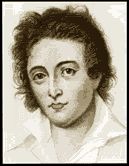
 Into The Past
Into The Past
Calliope's Place
Animated Verse
Links
Latest News
Into The Past
Open Book
Poets & Poetry
Email Us
Short Stories
Percy Bysshe Shelley (1792-1822)


Biography
English Romantic poet who rebelled against English politics and conservative values. Shelley was considered with his friend Lord Byron a pariah for his life style. He drew no essential distinction between poetry and politics, and his work reflected the radical ideas and revolutionary optimism of the era. Like many poets of his day, Shelley employed mythological themes and figures from Greek poetry that gave an exalted tone for his visions.
Percy Bysshe Shelley was the heir of a rich estate acquired by his grandfather. He was born at Field Place, near Horsham in Sussex, into an aristocratic family. His father, Timothy Shelley, was a Sussex squire and a member of Parliament. Shelley attended Syon House Academy and Eton and in 1810 he entered the Oxford University College.
In 1811 Shelley was expelled from the college for publishing THE NECESSITY OF ATHEISM, which he wrote with Thomas Jefferson Hogg. They both refused to answer any questions about the pamphlet, which had been sent to the heads of the colleges and a number of bishops. Shelley's father renounced his inheritance in favor of a small annuity, after he had eloped with the 16-year old Harriet Westbrook, the daughter of a London tavern owner. The pair spent the following two years traveling in England and Ireland, distributing pamphlets and speaking against political injustice. Shelley tried to set up a small community of free spirits At Lynmouth in Devon. He moved to Wales after finding out, that he was watched by Home Office spies because of his radical activities and writings. While living at Tanyrallt in Carnarvonshire he was attacked by a shepherd who fired three shots at him. Shelley continued his nomadic living and published in 1813 his first important poem, the atheistic QUEEN MAB.
The poet's first marriage turned to be failure. In 1814 Shelley traveled abroad with Mary Wollstonecraft Godwin, the daughter of the philosopher and anarchist William Godwin (1756-1836). Also Mary's young stepsister Jane (Claire) Clairmont was in the company. During this journey Shelley wrote an unfinished novella, THE ASSASSINS (1814). The combined journal, SIX WEEKS' TOUR, reworked by Mary Shelley, appeared in 1817. After their return to London, Shelley came into an annual income under his grandfather's will. Harriet drowned herself in the Serpentine in 1816. Shelley married Mary Wollstonecraft and his favorite son William was born in 1816 - William died a few years later in Rome.
The poet's first marriage turned to be failure. In 1814 Shelley traveled abroad with Mary Wollstonecraft Godwin, the daughter of the philosopher and anarchist William Godwin (1756-1836). Also Mary's young stepsister Jane (Claire) Clairmont was in the company. During this journey Shelley wrote an unfinished novella, THE ASSASSINS (1814). The combined journal, SIX WEEKS' TOUR, reworked by Mary Shelley, appeared in 1817. After their return to London, Shelley came into an annual income under his grandfather's will. Harriet drowned herself in the Serpentine in 1816. Shelley married Mary Wollstonecraft and his favorite son William was born in 1816 - William died a few years later in Rome.
The summer of 1816 Shelley spent with Lord Byron at Lake Geneva, where Byron had an affair with Clairmont. Shelley composed HYMN TO INTELLECTUAL BEAUTY and MONT BLANC. Mary Wollstonecraft started her famous novel Frankenstein. In 1817 Shelley published his political pamphlet THE REVOLT OF ISLAM, a poem, where the principal characters, originally brother and sister, become lovers. Cynthna, a maiden, joins forces with revolutionary Laon. They are burned alive as a sacrifice to the famine and pestilence which follows the people's revolt. In the poem 'Ozymandias' (1818) Shelley commented the fleeting nature of fame and power. Ozymandias is the Greek name for Ramses II of Egyp. His ruined statue is in the desert. On the pedestal is written: "Look on my works, ye Mighty, and despair!" but there is nothing to see but sand.
In 1818 the Shelleys and Clairmount moved to Italy, where Byron was residing. In 1819 they went to Rome and in 1820 to Pisa. Shelley's works from this period include JULIAN AND MADDALO, an exploration of his relations with Byron, PROMETHEUS UNBOUND, a lyrical drama drawn from Aeschylus Prometheus Bound. "Peace is in the grave. / The grave hides all things beautiful and good: / I am a God and cannot find it there." THE CENCI was a five-act tragedy based on the history of a 16th-century Roman family, and THE MASK OF ANARCHY was a political protest which was written after the Peterloo massacre. "One by one, and two by two / He tossed them human hearts to chew."
In 1822 the Shelley household, which now included Jane and Edward Williams, moved to the Bay of Lerici. There Shelley began to write THE TRIUMPH OF LIFE. To welcome his friend Leigh Hunt, he sailed to Leghorn. As much as he was near and on the water Shelley never learned to swim or navigate. He also forecasted many times his death by drowning. During the stormy return voyage to Lerici, his small schooner the Ariel sank and Shelley drowned with Edward Williams on July 8, 1822. The fisheaten bodies were washed ashore at Viareggio, where, in the presence of Lord Byron and Leigh Hunt, they were burned on the beach - his heart was given to his wife, who carried it with her in a silken shroud everywhere she went for the rest of her life. Shelley was later buried in Rome. There is a rumor that an old Italian seaman confessed on his deathbed that he had been a crewmember on a boat that collided intentionally with Shelley's ship in order to steal money hidden on board.






